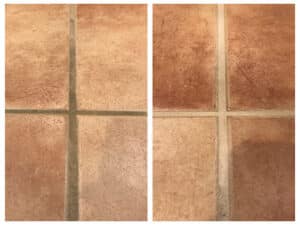How Can I Keep Grout Clean and New Looking?

Ceramic tile floors are beautiful, durable, and easy to maintain. The problem with maintaining the new look of ceramic tile floors is not the tile itself but keeping the grout clean. Understanding how the grout gets dirty in the first place is half the battle. When people walk into a home they track in dirt from outside and it collects on the largest part of the floor, the tile. It’s not until the homeowner tries to clean the floor that the grout really gets dirty. Most homeowners will try to clean the floor by using a mop bucket and water. The water and the detergent grab the dirt and oils off the tile and push them to the lowest part of the floor, the grout lines. Grout acts like a sponge soaking up the water and which pulls the dirt, oil and detergent deep into the pores of the grout. As the floor dries the water evaporates leaving everything else behind. The oil and cleaning detergents become sticky and grab and hold on to anything they can, making your grout lines a dirt magnet. So how should you clean tile floors?
How to Properly Clean Your Tile and Grout
Regular floor cleaning will help minimize the opportunity for dirt to find its way into your grout. Always vacuum or sweep your entire tile floor thoroughly to remove all the loose dirt and dust before wet cleaning.
A damp mop (Swiffer type or microfiber mop) works well. Using neutral or mild cleaners are all that is necessary to effectively clean tile. Look for floor cleaners that indicate they are neutral tile floor cleaners, safe to be used for daily use. Neutral is a pH of 7. This can be applied to the tile using a spray bottle. Lightly spray the floor and let dwell about 2-3 minutes. This will allow the cleaner to begin to loosen the soil. Remember to use as little water as necessary. If water does to get in the grout lines, it is best to remove it using a clean towel as soon as possible.
Protecting the Grout
Sealers are often used to help protect stone or grout from soils and stains. Sealers accomplish this one of two ways. A topical sealer puts a coating on top of the grout to prevent water and stains from penetrating the grout. An example of this topical grout sealer would be called grout color seal. An impregnating or penetrating sealer uses a carrier, of either water or solvent, to allow solids to soak into the grout to fill the pores in the porous grout and repel water and often oil. A sealer that resists water-based spills is hydrophobic and a sealer that also resists oil-based soils and spills is oleophobic. The decision to seal is dependent on what you are trying to accomplish. Some homeowners choose not to seal but regularly have their floors professionally cleaned. If you choose to seal your grout with an impregnating clear sealer, read the label and apply accordingly as often reapplying is needed every 6-18 months. If you choose a quality, professionally installed topical sealer, it may last for years and is the easiest to way to keep your grout clean and looking new.
Prevent Stained Grout With Professional Cleaning
Having your floors professionally cleaned every 6-12 months will go a long way in keeping your tile and grout looking new. A professional deep clean will remove dirt, oils and bacteria that found its way deep into the pores of the grout and out of reach from DIY grout cleaning methods. Having your tile and grout cleaned once a year will limit the chance of staining setting in permanently. At Beyond Clean Tile we use hot water extraction to clean tile and grout floors. First we will mop on an emulsifier to loosen any dirt or oils. Then we will use our truckmount system which heats the water to about 200 degrees and pressurizes it to flush out the soiling that is deep in the grout. The dirty water is immediately extracted through the vacuum system and taken out to our van. After the cleaning is done the tile and grout dry quickly and the floors look as good as new.
